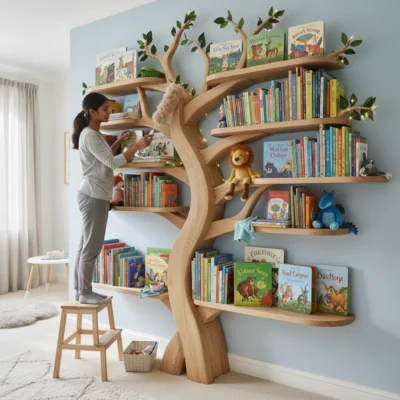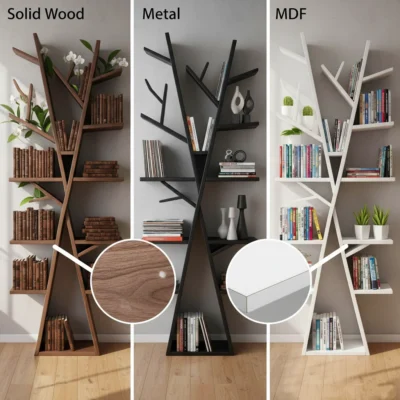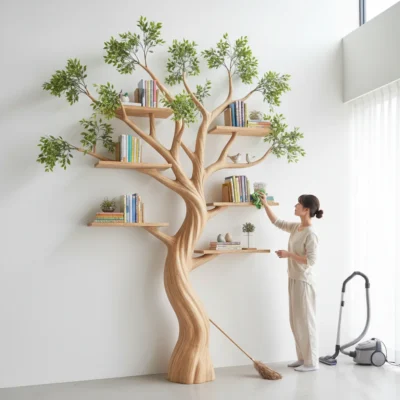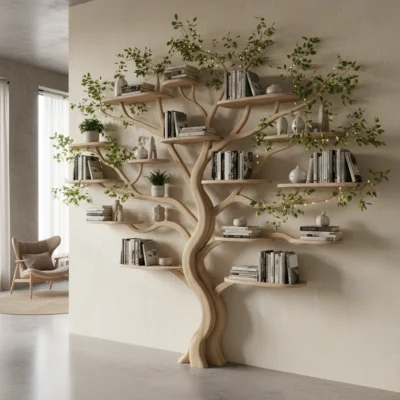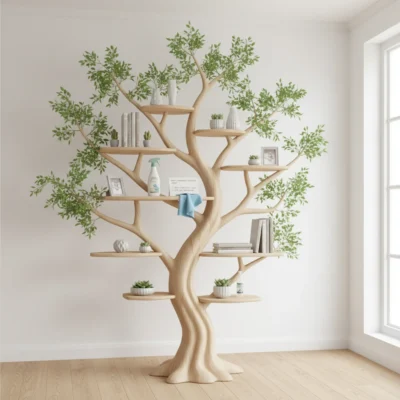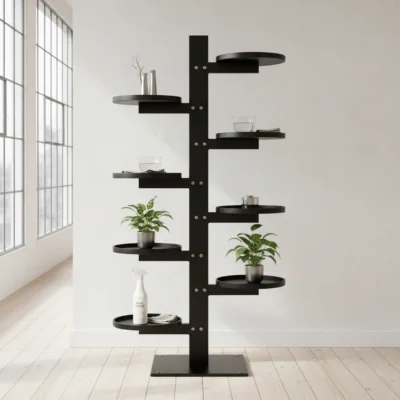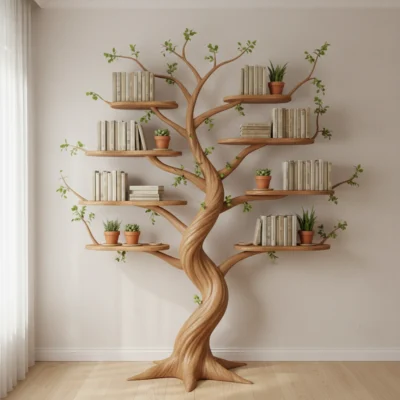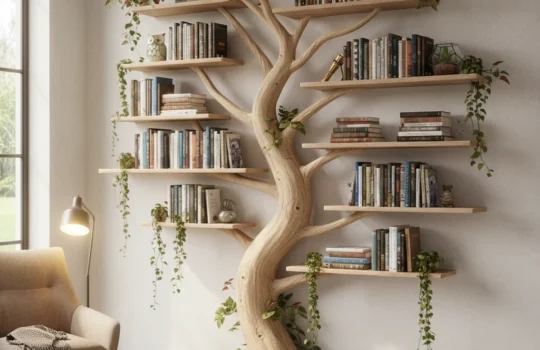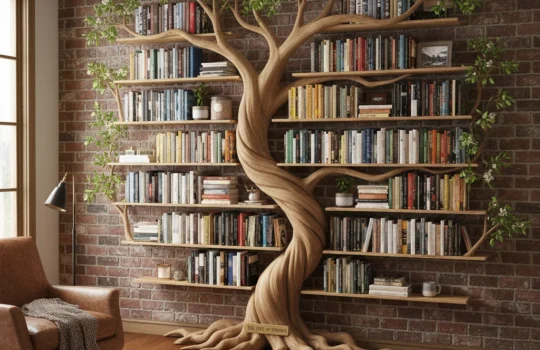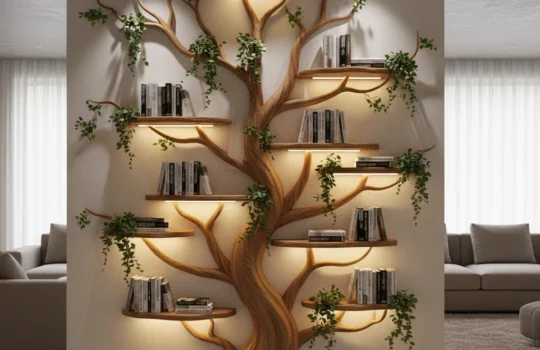How to Maintain and Clean Your Tree Shaped Bookcase
A tree-shaped bookcase isn’t just a place to store your favorite reads — it’s a striking piece of decor that combines functionality with artistic design. Its unique, branch-like structure adds character to any room, making it a favorite among book lovers and interior enthusiasts alike. But like any furniture, it’s not immune to dust, fingerprints, or daily wear and tear, especially if it’s placed in a high-traffic area. Over time, neglecting maintenance can dull its appearance or even shorten its lifespan.
The good news? A little regular care goes a long way. In this guide, you’ll learn simple yet effective tips to clean and maintain your tree bookcase whether it’s made of wood, metal, or a painted finish — so it stays beautiful and sturdy for years to come.
Understand the Material of Your Tree Bookcase
Common Materials Used
Before you start cleaning your tree bookcase, it’s important to know what it’s made of. Different materials not only affect the look and feel of the shelf, but also how you should care for it:
- MDF (Medium Density Fiberboard): A popular and affordable option that often comes with a painted or laminated finish. While durable, it’s sensitive to moisture.
- Solid Wood (e.g., oak, pine, walnut): Known for its natural beauty and strength. Each type of wood may react differently to cleaning agents and humidity.
- Metal or Metal-Frame Hybrids: These often feature sleek designs and are usually low-maintenance, though they can be prone to scratches or rust if not cared for properly.
- Laminated Particleboard: Common in budget-friendly designs. While easy to clean, it can peel or warp if exposed to too much moisture or harsh chemicals.
Why Material Matters for Maintenance
Knowing the material of your tree bookcase is key to choosing the right cleaning method. Each surface has its own care requirements — for example, solid wood benefits from gentle wood-safe cleaners, while laminated finishes need non-abrasive products. Using the wrong cleaning product or too much water can lead to discoloration, warping, or surface damage over time.
By understanding the material first, you’ll be better equipped to keep your bookcase looking its best for years to come.
Regular Cleaning Routine
Keeping your tree bookcase clean doesn’t have to be a chore — a consistent routine will help maintain its appearance and extend its life, no matter the material. Here’s how to care for it week by week and month by month.
Weekly Dusting
Dust can build up quickly, especially on open or branch-style shelves. A quick weekly dusting helps prevent buildup and keeps your bookcase looking fresh.
- Use a microfiber cloth or a feather duster to gently remove dust without scratching the surface.
- Always dust from top to bottom — this way, any dust that falls can be cleaned as you go.
- Don’t forget the inner corners, edges, and areas under each “branch” — these spots often collect the most dust.
Monthly Deeper Cleaning
A deeper clean once a month helps tackle what weekly dusting might miss, especially in tight or hard-to-reach spots.
- Wipe down surfaces with a slightly damp cloth using warm water or a drop of mild dish soap (especially for wood or laminate).
- Be sure to dry the surface immediately with a soft, dry towel to prevent water damage, particularly on MDF or wood.
- For tight spaces or decorative crevices, use a vacuum with a brush attachment to lift out dust without scratching.
Deep Cleaning Tips (Material-Specific)
When it’s time for a deeper clean, your approach should depend on the material of your tree bookcase. Different materials react differently to moisture, cleaning products, and scrubbing, so using the right method helps preserve both the look and lifespan of your piece.
For Wood Bookcases
Wood bookcases need a gentle touch to maintain their natural finish and prevent damage.
- Use a wood-safe cleaner or a homemade solution of 1 part vinegar to 3 parts water for effective, non-toxic cleaning.
- Never soak the wood or let water sit on the surface — excess moisture can cause warping or stains.
- Every few months, apply a wood polish or conditioner to nourish the surface and keep the finish looking rich and even.
For MDF or Laminated Surfaces
MDF and laminated finishes are popular for their affordability and smooth appearance, but they’re also more vulnerable to moisture and harsh cleaners.
- Avoid abrasive pads or strong chemical cleaners, which can scratch or damage the surface.
- Use a slightly damp cloth with a drop of mild dish soap to gently clean away dirt or smudges.
- Always wipe dry immediately to prevent swelling, peeling, or separation of the laminated layer.
For Metal Frames
Metal or metal-accented bookcases are generally durable, but they still need proper care to avoid corrosion and wear.
- Use a non-abrasive cleaner or diluted dish soap solution to clean the surface.
- After cleaning, dry thoroughly with a soft cloth to prevent water spots or rust, especially around joints or bolts.
- Take a moment to check for any loose screws or connections — tightening them ensures the structure stays stable over time.
Preventative Maintenance
Taking small, proactive steps can go a long way in keeping your tree bookcase looking great and standing strong for years. Preventative maintenance isn’t complicated — it’s just about being mindful of how and where you use your shelf.
Avoid Overloading Shelves
Tree bookcases are designed to be both decorative and functional, but they do have their limits.
- Always follow the manufacturer’s weight recommendations to avoid putting too much stress on the structure.
- Overloading branches especially thinner or unsupported ones can lead to warping, sagging, or even breakage over time. Distribute weight evenly and avoid stacking heavy books all on one side.
Keep Away from Direct Sunlight and Moisture
Where you place your bookcase matters just as much as how you use it.
- Direct sunlight can cause fading, drying, or cracking, especially on wood or painted surfaces.
- Moisture or high humidity may lead to swelling, warping, or peeling, especially for MDF or laminated finishes. Try to keep your bookcase away from windows, radiators, and damp corners.
Use Felt Pads or Coasters
It’s the little things that help protect your bookcase’s surface in the long run.
- Place felt pads, coasters, or soft mats under heavy objects, plant pots, or decorative items to prevent scratches, dents, or pressure marks.
- This is especially helpful for preserving painted or polished finishes, and it makes rearranging items easier too.
Seasonal or Annual Check-ups
Just like any well-loved piece of furniture, your tree bookcase can benefit from a little extra attention once or twice a year. A quick seasonal or annual check-up helps catch small issues before they become bigger problems and keeps your bookcase looking its best over time.
Inspect for Damage
Even with regular care, wear and tear can sneak in especially if the shelf is heavily used or frequently rearranged.
- Look for signs of damage like small cracks, loose screws, or any sagging branches or shelves.
- Tighten any loose hardware and address small issues early to prevent further strain or structural problems. Catching these things early can help extend the life of your bookcase significantly.
Refinish or Touch Up (if needed)
If your bookcase is starting to show its age, a little refresh can go a long way.
- For wooden bookcases, consider lightly sanding and reapplying wood stain or a protective finish to restore its original look and protect it from future damage.
- For painted surfaces, use matching touch-up paint to cover scuffs, chips, or worn edges. A small update can make your piece look brand new again without the need for a full replacement.
Keeping Your Tree Bookcase Beautiful and Strong
Taking good care of your tree-shaped bookcase ensures it remains a beautiful and functional centerpiece in your home for many years. Understanding the material it’s made from is the first step toward choosing the right cleaning and maintenance methods. By sticking to a regular cleaning routine—dusting weekly and doing deeper cleans monthly—you can keep dust and grime at bay without risking damage. Preventative maintenance, like avoiding overloading shelves and protecting your bookcase from direct sunlight and moisture, helps maintain its structure and appearance.
Seasonal check-ups allow you to catch any small problems early, whether it’s tightening screws or touching up the finish. With just a bit of consistent effort, your tree bookcase will continue to showcase your love for books while adding a unique touch of style to your space.


